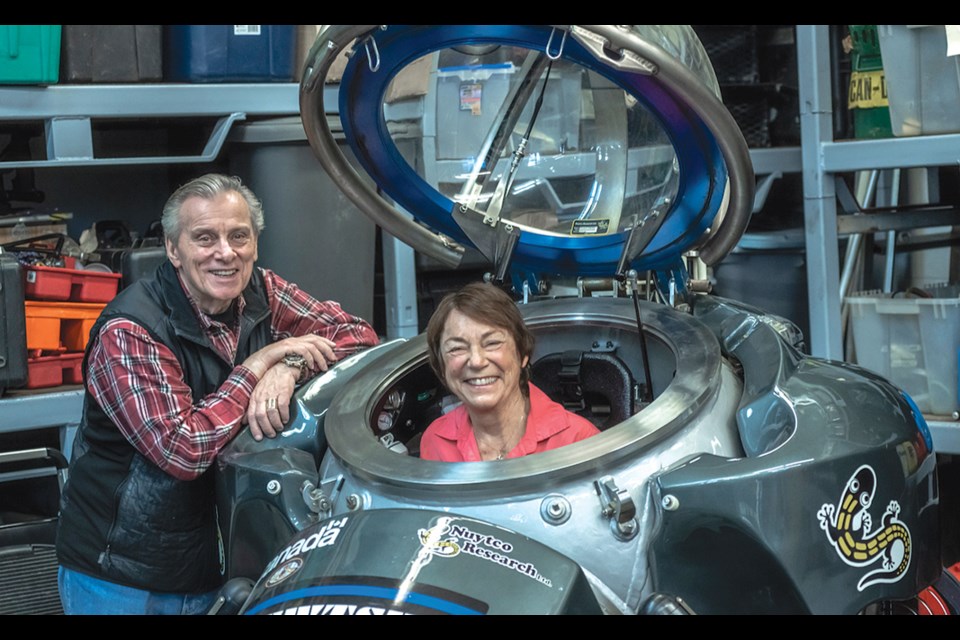When author Vickie Jensen visits the Gibsons & District Public Library on March 12 to read from her latest book, she will be returning to the location that helped launch her reputation as a documentarian of West Coast industry.
In 1985, while researching her first full-length work, Carving a Totem Pole, Jensen toured a log sort yard near Gibsons where Nisga’a carver Norman Tait selected the 42-foot cedar that became the focal point of Jensen’s text and photography. “I feel like I’m almost coming home,” Jensen said. “Back then, Gibsons was new territory for me.”
The Vancouver-based writer and editor has chronicled aspects of B.C.’s waterfront sector in other volumes—including Saltwater Women at Work and Ships of Steel: A British Columbia Shipbuilder’s Story—among her 13 previous titles. But the four years of research for her latest book took her beneath the surface, as she plotted characters and key developments in B.C.’s submarine sector. Deep, Dark & Dangerous: The Story of British Columbia’s World-Class Undersea Tech Industry was released late last year by Harbour Publishing.
The book collects the stories of larger-than-life industry pioneers like Phil Nuytten, a leading developer of deep-sea diving suits, and Al Trice, who co-founded International Hydrodynamics (HYCO), a company that spawned a generation of revolutionary submersible vehicles.
HYCO’s Pisces-series subs were adapted by the Russian government to create the Mir-class craft used by filmmaker James Cameron to survey the wreck of RMS Titanic. For its impact, the Pisces was chosen as the subject of a Soviet-era postage stamp. Nuytten’s company, Can-Dive, was itself contracted to work on Cameron’s film The Abyss.
Despite such high-profile gigs, and a global reputation for high-value underwater engineering, the divers and entrepreneurs who built the industry on the Vancouver foreshore rarely made waves in popular culture.
“When you spend four years interviewing these amazing guys, [and] there’s certainly some women too, you get so invested in their stories,” Jensen said. “Yet basically nobody knows about them. Nobody knows about the subsea industry locally. And you know, beginning in the 1960s, B.C.’s subsea tech industry built this world-class reputation. Certainly there are things happening all over the globe nowadays, but it’s still unrecognized.”
Jensen describes the evolution of sonar through the initiative of Helmut Lanziner, who oversaw offshore surveying for Can-Dive. In the mid-1970s, side-scan sonar had only just been introduced in Canada. With a group of apprentices, Lanziner mounted an expedition to find the wreck of Gulf Master, a tugboat that sank in 1967 off Trail Island, near Sechelt, with the loss of five lives.
“There wasn’t a manual, there were no textbooks in those days,” said Jensen. “You couldn’t go online and google how to use a side-scan sonar. It was just an amazing experience for those students [of Lanziner’s] because they put the side-scan in the water, using search grids—they often call it ‘mowing the lawn’ because you’re doing one line then turning around and coming back—and within a couple of hours they found it.”
For one of Lanziner’s apprentices, underwater photographer Mark Atherton, the wreck’s discovery crystallized his nascent passion for undersea exploration. Following decades of commercial underwater survey work, he published an encyclopedia of scanning sonar operations in 2011.
“If you wanted to work in the subsea industry, Vancouver and North Van and the Lower Mainland—that’s where you came, because that’s where the action was,” said Jensen.
Her book’s anecdotes reveal contributions by industry leaders to watershed moments in B.C. history: rescue efforts after the Second Narrows Bridge collapse in 1958, construction of the W.A.C. Bennett Dam, and submarine technology displayed at Expo ‘86.
Jensen was previously the editor of Westcoast Mariner magazine. Her reading at the Gibsons library begins at 2 p.m. on March 12, and will also be accessible via Zoom. Registration details are available at gibsons.bc.libraries.coop.



